Dubai Metro: A Key to Urban Life and Investment
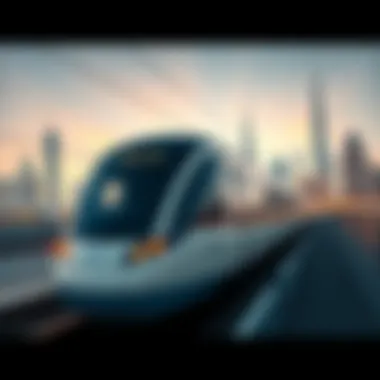
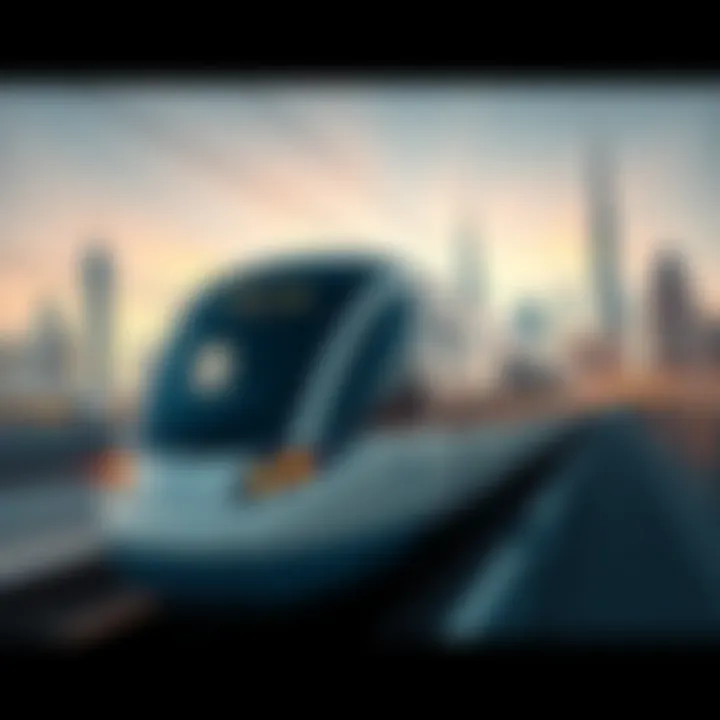
Intro
The Dubai Metro is more than just a transport system; it is a lifeline for the city, stitching together the diverse fabric of urban life in this rapidly evolving metropolis. As a pioneer in modern infrastructure, the metro plays a crucial role not only in commuting but also in shaping real estate trends across Dubai. This article embarks on an exploration of the Dubai Metro, examining key aspects like its infrastructure, its integration with real estate markets, and the economic ramifications for both investors and residents.
By delving into how the metro influences property values and urban living, we can better appreciate its significance in today's dynamic landscape. Understanding this interaction is invaluable for anyone looking to invest, live, or work in Dubai. As we navigate through the details of this project, an enlightening perspective on the metro's relevance in Dubai will unfold.
Prelims to the Dubai Metro
The Dubai Metro stands as a testament to the city’s rapid transformation from a modest desert settlement to a bustling metropolis. It is not just a means of transportation; it embodies the pulse of urban life, a vital thread that weaves together the diverse fabric of the city. With its sleek design and advanced technology, the metro has redefined what commuting means for both residents and tourists alike.
In this section, we explore the inner workings of the Dubai Metro, laying out its historical foundations and current operational frameworks. Understanding these elements is crucial, especially for those interested in the interconnections between urban transit systems and real estate value trends. The metro enhances accessibility, improves daily life for many, and boosts the overall economy. These factors make it a linchpin in Dubai's ongoing urban development strategy.
Historical Background
When Dubai initiated the project to build its metro system in the early 2000s, few could imagine the scale of impact it would have. The groundbreaking occurred in 2006, marking the beginning of a journey aimed at addressing the challenges of a rapidly growing population and increasing traffic congestion. Investment in public transportation infrastructure was seen not just as a necessity, but as a bold statement about the city's ambitions.
The metro commenced operations in 2009, with the Red Line opening first, followed shortly by the Green Line. This ambitious endeavor involved extensive planning and engineering challenges, from the construction of tunnels to the management of sophisticated signaling systems. What many may not know is that the metro is fully automated, with no drivers on board, a feature that not only saves operational costs but also enhances safety.
Over the years, the expansion of the network has showcased the city’s commitment to sustainable living. The intention was clear— to create an efficient transport solution that would ease the burden on roads, reduce carbon emissions, and provide an accessible means of travel for everyone. Today, the metro covers over 75 kilometers and includes a combination of above-ground and underground tracks, connecting key districts and facilitating commutes across a sprawling urban landscape.
Current Operational Framework
Today, the Dubai Metro operates under a well-structured framework designed to ensure efficiency and reliability. The Roads and Transport Authority (RTA) governs its operation, ensuring that it meets stringent safety and operational standards. Comprising two main lines, the metro network integrates seamlessly with other forms of transportation, such as buses and water taxis, creating a comprehensive public transit system.
Regularly scheduled services, along with easy access to metro stations, make it a highly used option. Ridership has continued to soar, with millions of passengers utilizing the service annually. The RTA constantly evaluates and upgrades the system, introducing new technologies and amenities to enhance the user experience.
Factors like contactless payment methods and user-friendly mobile applications ensure that commuters can navigate with ease. With air-conditioned carriages and modern amenities, the metro is tailored to meet the expectations of a cosmopolitan city. Moreover, the strategic placement of stations has been thoughtfully planned to ensure that they are within walking distance from high-density residential areas and commercial hubs.
"The Metro is not just about transport, it's about connecting lives and enhancing the overall urban experience."
These operational principles culminate in offering a transit system that is more than just a mode of travel; it is a lifeline for the residents and a critical component of infrastructure that supports Dubai’s position as a global city.
Significance in Urban Development
The Dubai Metro serves as a cornerstone in the broader context of urban development within this vibrant city. It’s more than just a means of getting from point A to point B; it’s a transformative element that reshapes how individuals interact with, engage in, and envision their urban environments. The importance of the Dubai Metro can be distilled into several key factors; primarily, its role in enhancing connectivity and bolstering economic growth.
Enhancing Connectivity
The notion of connectivity within a city can often spell the difference between a bustling metropolis and a gridlocked nightmare. The Dubai Metro has been instrumental in improving transportation access across various districts, creating a web of efficiency that draws people in and drives development forward. Consider the demographic diversity of those who use it—from daily commuters to tourists—each benefiting from the accessibility afforded by this rapid transit system. The integrated transit options, such as buses and taxis, further simplify the journeys of those relying on the Metro. It brings areas of the city closer together, reducing travel times.
- Seamless Transfers: With strategically placed interchanges, riders can switch from the Metro to other modes of transport without breaking a sweat. This efficient design means that more neighborhoods are suddenly accessible, not only improving daily commutes but also opening doors for social interactions.
- Affordability: The ticket pricing is set to ensure that the Metro remains an attractive option for many, allowing residents from various economic backgrounds to navigate the city more easily. This democratization of mobility means that individuals can work, shop, and play in locations that may have previously felt unreachable due to congestion or high transport costs.
This elevated level of connectivity does not just benefit individual passengers; it serves to uplift entire communities. It can rejuvenate neighborhoods that were historically underserved, making them prime targets for investment and development.
Supporting Economic Growth
Economic growth in a city is often linked to its infrastructure. The Metro system stands as a testament to this principle, acting as both a catalyst and a backbone for economic expansion in Dubai. When evaluating the link between mass transit and economic viability, it’s clear that the Metro has played a significant role in uplifting property values and attracting business investments.
- Property Value Trends: Proximity to Metro stations tends to correlate with rising property values. Neighborhoods near stations often experience increased interest from homebuyers and investors alike. This adds layers to the real estate market, as properties near transport hubs become highly coveted assets.
- Business Opportunities: Entrepreneurs see a goldmine of potential in areas surrounded by Metro stations. The influx of commuters not only increases foot traffic but also creates a vibrant consumer base for local businesses, restaurants, and shops. This often leads to a symbiotic relationship where businesses thrive and in turn create more job opportunities.
Infrastructure and Design
The infrastructure and design of the Dubai Metro play a key role in its success as a modern transport solution. This system not only facilitates movement through the bustling city but also represents a large-scale commitment to urban planning and sustainable development. By focusing on these elements, residents and investors can better understand how the Metro influences the broader urban landscape and what benefits emanate from this meticulously crafted transport mechanism.
Station Architecture
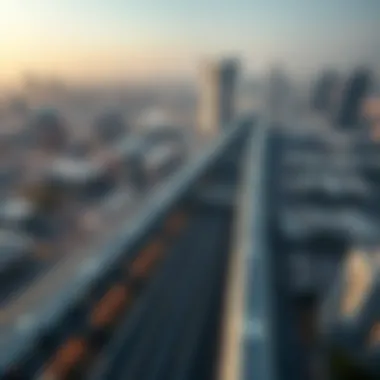

The architecture of Dubai Metro stations is a sight to behold. Each station is crafted with precision and reflects a modern aesthetic that aligns well with Dubai’s skyline. Sleek lines and spacious interiors create an inviting atmosphere for commuters.
- Natural Light: One notable design element is the utilization of natural light. Large glass panels not only brighten the waiting areas but also provide a clear view of the stations' surroundings. This feature enhances user experience and minimizes the reliance on artificial lighting.
- Multi-functional Spaces: Many stations incorporate retail components, offering coffee shops, convenience stores, and even art installations. This approach creates more than just a transit hub; it transforms them into social spaces where people can gather, relax, and connect.
Additionally, design incorporates accessibility. Elevators and ramps ensure that everyone, regardless of mobility challenges, can navigate through the stations comfortably. This attention to detail exemplifies a commitment to inclusivity in urban design.
Rail Network Specifications
The rail network specifications of the Dubai Metro reveal the thoughtful engineering and technology that underpin this transit system. Operating on two primary lines—the Red and Green lines—the Metro covers an impressive 90 kilometers, with plans for expansion on the horizon.
- Train Specifications: Trains are equipped with advanced features such as automatic train operation, which enhances safety and efficiency. Able to reach speeds of up to 110 kilometers per hour, the Metro allows commuters to move swiftly across the city. This rapid transit is crucial for those who squeeze their workdays into tight schedules.
- Infrastructure: Overhead elevated tracks minimize land usage and reduce the impact on ground-level traffic, a vital aspect in a fast-growing city like Dubai. The dual-track design enables trains to operate efficiently in both directions without delays.
Moreover, continuous upgrades are planned to meet future demands, including enhancements to safety features and system reliability. Overall, the infrastructure and design elements of the Dubai Metro reflect a balance between high functionality, user convenience, and environmental consciousness, making it a benchmark for urban transit systems globally.
"The evolution of the Dubai Metro shows how transport solutions can shape the fabric of a city, fostering connectivity and inclusivity for all residents."
In summary, the infrastructure and design choices are not just about aesthetics; they are crucial in ensuring the Metro is sustainable, efficient, and accessible for everyone. Investors and urban planners alike should take heed of these developments as they signify much more than just public transport—they represent the future of urban living in Dubai.
Economic Impact on Real Estate
The economic impact of the Dubai Metro on real estate cannot be overstated. The mere proximity to a metro station can drastically alter the value of the neighborhood around it. Investors and homeowners alike are increasingly recognizing that a bustling metro system serves as a major driver for property demand and value appreciation. Access to reliable public transport enables residents to travel across the city effortlessly, thus inviting more people to live and work within close reach of metro lines.
Property Value Trends Near Stations
The presence of metro stations has been linked to significant increases in property values. For instance, real estate expert reports show that properties located within a 500-meter radius of a metro station in Dubai have experienced a notable rise in asking prices. In fact, some areas reflect up to a 20% appreciation in value over the past five years.
- Immediate Estates: The neighborhoods around Burj Khalifa Metro Station have seen prices soar, leading to burgeoning developments and new housing projects.
- Emerging Hotspots: Bur Dubai, for example, showcases a mix of old-world charm and modern amenities, with property values steadily climbing as the metro expands.
- Long-term Trends: Following the completion of a new station, analysis indicates an uptick in average property prices that can persist for several years. Investors often capitalize on these upward trends by acquiring properties during construction phases, predicting substantial returns.
"A well-placed metro station is akin to planting a seed; as the roots grow, the surrounding land flourishes."
The trends observed near the metro stations demonstrate how instrumental public transport is in shaping the residential landscape. Buyers today are highly informed, and they often seek properties that are well-connected, further solidifying this relationship.
Investment Opportunities Arising from Accessibility
As accessibility improves, so too does the potential for capitalizing on investment opportunities. Investors can find compelling reasons to focus on properties with metro access, particularly as Dubai's infrastructure continues to develop.
- Mixed-Use Developments: Projects that combine residential, retail, and leisure spaces near metro stations appeal to diverse demographics, making them attractive for investors. Developers like Emaar and Damac are tapping into this trend by crafting integrated spaces that promote community living while ensuring convenience.
- Commercial Prospects: The rise of new businesses along metro lines means commercial properties are likely to yield higher returns. Areas such as the Dubai Marina have shown significant growth in office spaces following the introduction of the metro link.
- Rental Income: For property investors, the demand for rental locations near metro stations remains robust. With housing supply tight, landlords can command premium rents for conveniently located apartments and homes, making the investment worthwhile.
Consequently, smart investors are closely monitoring areas poised for metro expansions. They anticipate that, much like past developments, the expansion will lead to a ripple effect, positively influencing surrounding neighborhoods. Thus, adapting to these trends is essential for those looking to make informed real estate decisions as the city develops.
Challenges Faced by the Metro System
The Dubai Metro system, while a tremendous accomplishment in urban transport, is not without its share of challenges. These challenges are critical to understanding how the metro functions and grows as a key element of the city’s infrastructure. Addressing operational efficiency and maintenance needs plays an important role in cementing the metro’s reliability and attractiveness to both residents and investors.
Operational Efficiency
The topic of operational efficiency in the Dubai Metro is significant and multifaceted. Efficiency impacts everything from commuter satisfaction to financial sustainability. The metro system handles a staggering number of passengers daily, often exceeding 600,000 during peak times. This level of demand necessitates an intricate balance between scheduling, staffing, and technology. Failure to manage these factors effortlessly can lead to overcrowding and delays, leaving users with a less-than-ideal experience.
For example, the integration of smart technology and real-time data analytics is crucial for ensuring trains run smoothly. The deployment of AI-driven systems for monitoring train performance and predicting maintenance needs offers a glimpse into a future where operational hiccups could be minimized. Nonetheless, achieving this level of efficiency requires substantial investment and ongoing commitment. We cannot overlook the importance of employee training; a well-trained workforce is indispensable in delivering optimal service.
Additionally, the social implications of operational efficiency are noteworthy. Improved efficiency doesn’t just benefit daily commuters; it also enables the overall urban landscape of Dubai to thrive. Businesses along the metro lines see increased foot traffic, thus enhancing local economies. In essence, efficient operations are more than mere logistics; they are a backbone supporting the city's financial vitality and communal cohesion.
Maintenance and Upgrades
Turning our attention to maintenance and upgrades, we see another layer of complexities that must be navigated. Every system ages, and the Dubai Metro is no exception. As the infrastructure undergoes the wear and tear typical of frequent use, timely maintenance is key to safety and reliability. Any faltering in this regard can lead to increased closure times or safety hazards, which ultimately tarnishes public confidence.
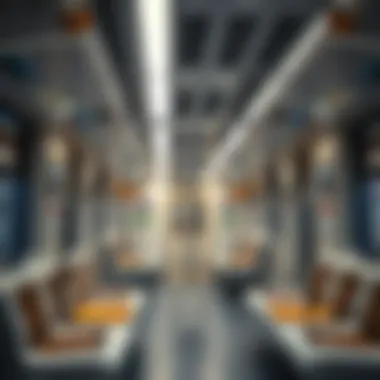

The challenge for Dubai Metro lies in its need to balance routine maintenance with the ongoing introduction of new technology. Regular inspections and updates are imperative to avoid costly emergencies down the line. In addition, upgrades must be planned skillfully to ensure that they are introduced without interrupting service. Upgrading signaling systems, for example, can enhance safety and efficiency but requires a well-crafted schedule to minimize passenger inconvenience.
As urban populations grow, the call for expanded services heightens, leading to conversations about how to extend existing lines or even introduce new ones. This brings another layer of complexity, as planning and executing upgrades requires not only funding but also an intricate understanding of urban growth trends. Striking a balance between immediate maintenance needs and future expansions is vital for both the metro system and its many stakeholders.
Social Benefits of the Metro
The Dubai Metro system plays a crucial role in shaping the social fabric of the city. Not only does it provide residents and tourists with reliable transportation, but it also directly influences urban dynamics. This section drifts into the importance of accessibility and traffic reduction, which are pivotal elements that underline the significant benefits offered by the Metro.
Accessibility for Residents and Tourists
A key attraction of the Dubai Metro lies in its accessibility. The Metro connects various neighborhoods to essential amenities and hotspots, making it easier for residents to reach their workplaces or enjoy leisure activities. This is particularly beneficial in a bustling metropolis like Dubai, where lifestyle options abound.
For residents, the Metro offers an affordable means of transport. Prices remain reasonable, allowing families of varying income levels to commute without breaking the bank. A ride can cost as low as four dirhams, which is a bargain compared to other transport options like taxis. Tourists also benefit significantly. With stops at major attractions like the Burj Khalifa and the Dubai Mall, it helps visitors explore the city seamlessly.
Moreover, the Metro stations are equipped with facilities for people with disabilities, ensuring that everyone can enjoy the service. This attention to inclusivity promotes social equity and provides individuals, regardless of their circumstances, access to the urban landscape.
Reduction of Traffic Congestion
Traffic congestion often plagues urban centers, but the Dubai Metro presents a solution. By shifting a significant number of commuters from roads to rail, the Metro directly contributes to reducing the number of cars on the streets. This translates to smoother travel for those who still prefer personal vehicles, as the roads become less congested.
Quantifying the impact, studies have shown that commuters can save considerable time during peak hours. Reports indicate that travel times have decreased by up to 30% for certain routes due to the reduced vehicle density. Additionally, less traffic translates to lower emission levels, contributing to a healthier urban environment.
The design of the Metro encourages people to choose public transport, making it not just a means of convenience but also a lifestyle preference. When families opt to use the Metro for school runs or work commutes, they contribute to a cultural shift toward sustainable transportation options.
"The Metro acts as a lifeline, weaving through the fabric of daily life in Dubai. It bridges gaps, connects neighborhoods, and ultimately transforms how we view urban travel."
Trends in Metro Usage
As the Dubai Metro continues to evolve and become a fixture in the urban lifestyle of this vibrant city, understanding trends in metro usage is paramount. This section delineates not just how people are interacting with this mode of transport, but also illustrates the profound implications of these trends for investors, planners, and developers.
Demographics of Users
The user demographics of the Dubai Metro represent a melting pot of nationalities, ages, and backgrounds. With residents, expatriates, and tourists frequently utilizing the service, analyzing this mix provides valuable insights into the metro's significance.
- Residents: A significant portion of daily commuters is local residents—many of whom rely on the Metro due to its cost-effectiveness and efficiency. Families often prefer it for daily school runs or errands.
- Expatriates: Given Dubai’s international workforce, expatriates make up another large segment of users. They often utilize the metro to navigate towards workplaces, particularly in areas like the Dubai International Financial Centre or near major shopping hubs.
- Tourists: The influx of tourists is another critical aspect, as many visitors rely on the metro to access key attractions such as the Burj Khalifa and the Dubai Mall. This interaction not only emphasizes the Metro's role in easing transportation but also highlights its importance in sustaining the tourism sector.
Such diverse demographics foster a dynamic environment where feedback and service adjustments can reflect the city’s growing needs.
Impact on Commute Times
Another significant factor in analyzing trends in metro usage is the impact on commute times. The Dubai Metro has revolutionized how inhabitants navigate the sprawling urban landscape. With a focus on efficiency, the service prides itself on punctuality and speed, bringing immense collective benefits.
- Reduction in Travel Times: Most notably, the metro can cut traditional commute times significantly. Commuters can traverse vast distances, such as from the Expo 2020 site to downtown in mere minutes, shrugging off what used to be lengthy car journeys.
- Convenient Connectivity: The interface of the metro with bus services and tram lines enhances overall accessibility, allowing users to transition between different forms of transport without missing a beat.
- Localized Traffic Relief: By diverting thousands of users from road networks, the metro contributes to reduced traffic congestion, translating to smoother journeys for those who opt for cars.
In essence, the trends in metro usage encapsulate a broader narrative of urban development and sophistication, pointing towards a sustainable model for future transport solutions.
"Understanding trends in metro usage is not just about numbers, it is about capturing the pulse of a modern city."
By staying attuned to these trends, stakeholders can better align development projects with the continual growth and mobility demands of Dubai, ushering in a new era of urban livability.
Future Developments and Expansion Plans
The future of the Dubai Metro holds great promise, reflecting the city's ambition to evolve and adapt in a rapidly changing urban landscape. With increasing population density and a surge in economic activity, the expansion of the metro is more than just a convenience; it's a strategic move essential for the growth of the city. Understanding the upcoming developments and their potential impacts provides valuable insights for investors, agents, and developers alike.
Upcoming Lines and Stations
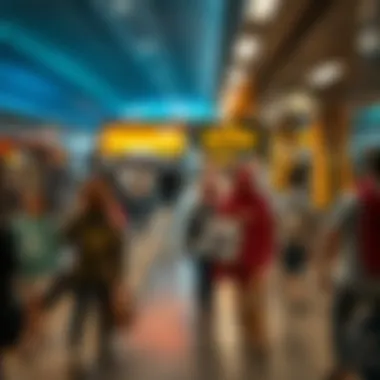
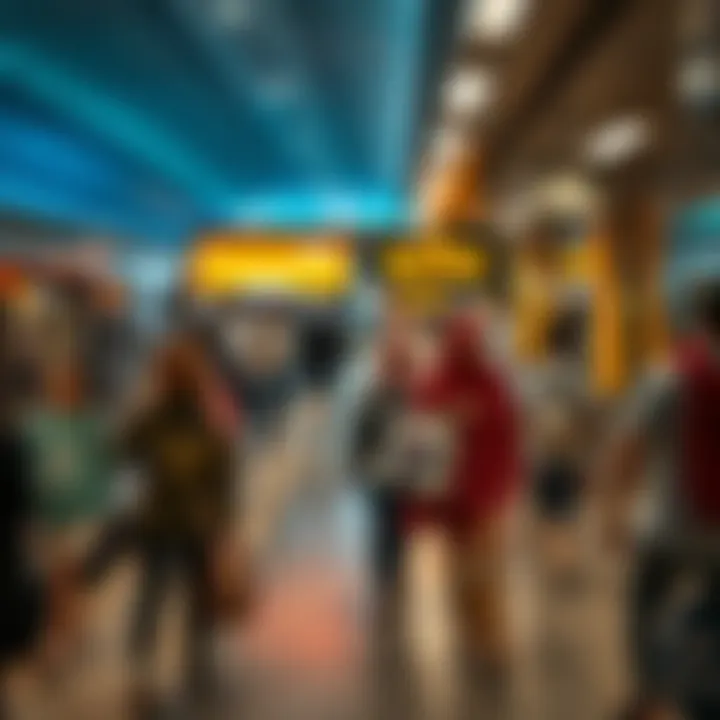
Dubai's metro expansion plans are as ambitious as the city itself, with several new lines and stations projected to come online in the near future. Among the most notable is the Dubai Metro Purple Line, which aims to connect existing key areas and improve accessibility. This new route will link neighborhoods like Al Khawaneej, enhancing connectivity to areas previously underserved by public transport.
- Major upcoming projects include:
- Purple Line: Aimed at reducing travel time among various neighborhoods.
- Blue Line: Proposal to link the Dubai Marina area with other vital hubs in the city.
- New stations being constructed along these lines are strategically positioned to facilitate ease for commuters.
These planned expansions signify a commitment not only to catering to the daily commuter but also to enhancing tourist experiences. With added stations, more visitors will find it easier to navigate towards popular destinations, directly impacting local business and the hospitality sector.
Long-term Urban Impact
The effects of these planned expansions stretch far beyond just improved transit times. In light of urban development principles, the integration of expanded rail lines can drastically reshape the socio-economic landscape of Dubai.
Investors should take note of the following long-term urban impacts:
- Increased Property Values: Areas near new metro stations typically see a rise in property prices, making real estate investment a more attractive option.
- Enhanced Accessibility: With better transport links, previously isolated neighborhoods can become more popular, elevating the demand for housing and commercial spaces in those regions.
- Sustainability Benefits: The metro operates on electricity, significantly reducing carbon footprints compared to traditional transport. Encouraging public transport can lead to lower congestion and pollution levels, enhancing overall quality of urban life.
- Urban Planning Transformation: Expanded metro networks necessitate careful urban planning, including zoning policies aimed to embrace mixed-use developments around stations, fostering vibrant communities.
"The ongoing development of the metro will not just reshape transport but will also transform lifestyles and economic patterns throughout the city."
Case Studies: Metro Influence on Specific Neighborhoods
The Dubai Metro is more than just a mode of transport; it is a transformative force shaping the urban landscape. This section delves into the intricacies of how the Metro has influenced specific neighborhoods, with a particular focus on its role in enhancing accessibility and stimulating local economies. Understanding these case studies highlights the importance of the Metro in urban planning and real estate investment in Dubai.
The Impact on Downtown Dubai
Downtown Dubai, often referred to as the city's beating heart, has felt the pulse of the Metro more than most areas. When the Metro was first completed, it revolutionized how residents and tourists navigated through this bustling hub. The close proximity of the Burj Khalifa and The Dubai Mall to the Burj Khalifa Metro station created a seamless flow of foot traffic.
- Increased Accessibility: Visitors from all over can easily reach iconic landmarks without the need for a car, fostering a sense of freedom. The Metro is not merely a transport option; it’s a catalyst for urban exploration.
- Economic Growth: Businesses in Downtown Dubai have seen a noticeable increase in footfall since the Metro's inception. From cafes to high-end retail shops along Sheikh Mohammed bin Rashid Boulevard, the economic benefit is palpable. Increased customer traffic translates to higher sales, enhancing the overall economic dynamism of the area.
- Property Value Surge: Properties adjacent to the metro line in Downtown have witnessed a significant uptick in value. Investors are keen to acquire real estate close to the Metro, making it a prime consideration for those exploring property opportunities.
"With the Metro, we saw more customers coming in. It's been a game-changer for our business," remarked a local café owner, highlighting the tangible benefits of this public transport system.
In summary, the Metro's impact on Downtown Dubai has been nothing short of profound. It is not just about mobility; it is a strategic tool for urban growth and investment.
Emerging Areas Benefiting from Metro Proximity
As the Metro expands, previously overlooked neighborhoods are emerging as attractive prospects for investors and buyers alike. Areas like Al Quoz and Dubai Design District have seen revitalization largely due to their Metro access.
- Al Quoz: This area has transformed from an industrial zone into a vibrant community, with the introduction of the Al Quoz Metro station. Artists and creative individuals are flocking to the area, drawn by the affordable spaces and relative proximity to key city points. The ease of commuting has elevated its desirability.
- Dubai Design District (d3): The Metro extension to d3 has catalyzed the growth of this creative hub. The mix of workspaces, art galleries, and vibrant cafés is becoming increasingly popular. Developers are keenly aware that easy access via the Metro enhances the appeal to both tenants and buyers. Local businesses report that their clientele has diversified since the Metro connections went live.
- Community Benefits: These emerging areas are also seeing a benefit in social terms. Easier access means more people can reach local amenities such as parks, shopping areas, and cultural institutions, fostering a sense of community and togetherness.
To conclude, the influence of the Dubai Metro extends beyond its primary function of transport. It is reshaping communities and neighborhoods, offering fresh opportunities for both development and investment. By studying these case examples, one can gain insights into the larger trends shaping Dubai's urban landscape.
Finale: The Future of Dubai's Urban Dynamics
The Dubai Metro stands as a pivotal element in reshaping the urban landscape of Dubai. This conclusion wraps up a discussion around the multifaceted influences the metro has on how residents, businesses, and investors engage with the city.
Sustainability and Urban Transit
As the globe increasingly turns its attention to sustainable practices, Dubai is no different. The metro not only alleviates road congestion but significantly diminishes the carbon footprint associated with traditional transportation. Optimizing energy consumption and promoting clean technologies within the rail network underscores Dubai's commitment to a greener future. The Metro's automated systems ensure efficient energy use, offering a testament to how urban transit can align with global sustainability goals.
Moreover, the introduction of eco-friendly trains and energy-efficient stations illustrates a shift towards environmentally responsible urban development.
Final Thoughts on Integration with Real Estate
The symbiotic relationship between real estate and the Dubai Metro is particularly illuminating. Properties located within walking distance of metro stations often experience accelerated appreciation in value. Investors are keenly aware of the trends that favor proximity to the metro, as it boosts rental demands and attracts businesses seeking accessibility for their clients and employees.
- Increased property values near stations
- Greater demand for residential and commercial spaces
- Enhancements in urban living standards
All of these aspects make understanding the influence of the metro critical for anyone interested in Dubai's urban real estate market.
In summary, as Dubai continues to evolve, so too will the metro system and its impact on the city. The future of urban dynamics is undeniably tied to how easily people can navigate their surroundings, and the Dubai Metro exemplifies this principle. The importance of fostering connectivity through urban transit cannot be understated, positioning the metro as a cornerstone of Dubai's ongoing growth.
"The importance of efficient transport systems in urban settings cannot be ignored; they are enablers of livability and prosperity."
With that in mind, keeping a close eye on advancements and expansions in the metro system is essential for those looking to invest or engage with the urban fabric of Dubai.















